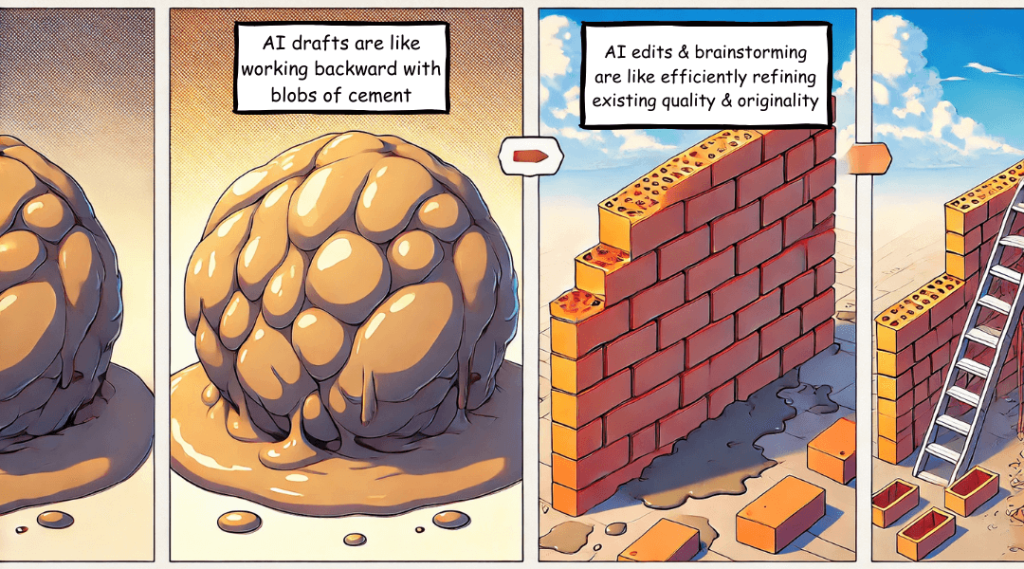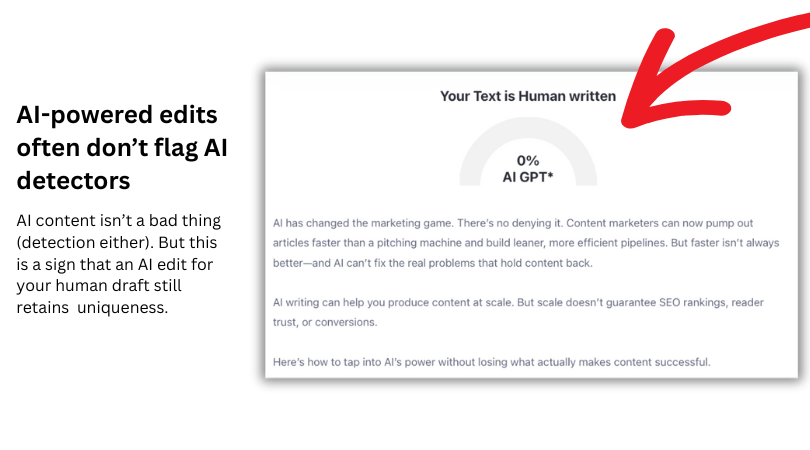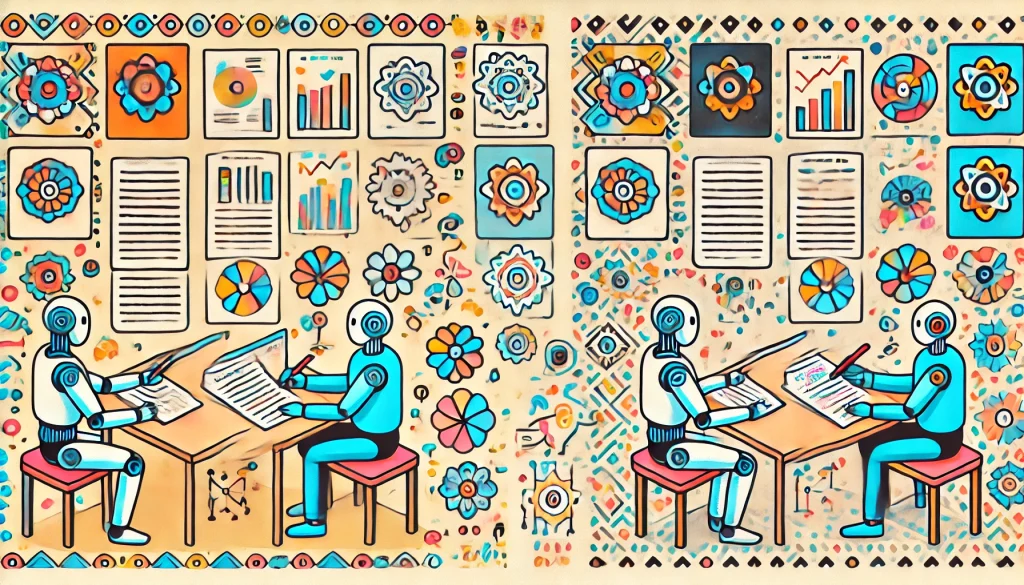AI has changed the marketing game. There’s no denying it. Content marketers can now pump out articles faster than a pitching machine and build leaner, more efficient pipelines. But faster isn’t always better—and AI can’t fix the real problems that hold content back.
AI writing can help you produce content at scale. But scale doesn’t guarantee SEO rankings, reader trust, or conversions.
Here’s how to tap into AI’s power without losing what actually makes content successful.
What AI-scaled content gets wrong
Most marketers know the rap sheet by now: Large language models (LLMs) like ChatGPT, Claude, and Perplexity don’t create anything new. They remix what’s already out there. You get stitched-together insights that often sound slick, but say little.
This raises a serious question from a business perspective: Why would a reader choose your content over anyone else’s in the search results?
If your content is just reworded noise, you’re not building anything lasting.
Google’s stance on AI-scaled content is clear. According to its quality rater guidelines:
“The lowest rating applies if all or almost all of the [main content]…is copied, paraphrased, embedded, auto or AI-generated…with little to no originality, and little to no added value.”
Translation: If you rely solely on AI to write, your content will tank in rankings and in reader interest.
Instead, aim for content your target audience wants to finish, share, and return to; content that leads them to trust your expertise.
That only happens when you inject what AI can’t:
- Your experience
- Your insight
- Your original thinking
Drop an expert opinion on a fresh development. Share internal data, a step-by-step template, or a personal take that no one else has published. That’s what earns trust and visibility.
Adopt an AI-powered human content strategy
This doesn’t mean you should swear off AI tools. Far from it. Think of AI as the flight attendant—not the pilot. Helpful, efficient, but not in charge. You still steer the creative direction. Below is a comparison of AI writing vs. AI-powered human writing:
| AI writing | AI-powered human writing |
|---|---|
| AI does the thinking | Humans do the thinking; AI supports brainstorming |
| AI generates the first outline | Humans create the outline based on expertise; AI fills in content gaps |
| AI writes the first draft; humans add a layer of insight afterward | Humans write the first draft with originality; AI enhances structure and flow |
| AI edits the draft | Humans use AI to refine the draft—saving time, not replacing thought |
| AI creates meta and micro copy | Humans guide meta and micro copy creation using AI, rooted in the original content |
Here’s how to leverage AI-powered human writing blog posts that scale:
Start by shaping your own thinking
Don’t let AI set the stage. Do it yourself. Before you prompt anything, write a rough outline. Nail down your angle. Sketch out your hot takes. Add bullet points with expert quotes, statistics, or controversial insights you want to include.
The goal is to anchor your article in your consistent voice and vision—not in AI’s recycled phrasing.
After you’ve mapped out your outline, you can task AI with filling in the blanks. Let it expand on sections within your outline, suggest intros or conclusions. That’s when AI becomes a valuable assistant, not a distracting co-author.
Use AI to fill gaps and then write the piece yourself

In my experience, AI-generated drafts often feel counterproductive. The output reminds me of how someone fills in the gaps between bricks with cement. Useful—but only once the real structure is built by a human. A cement glob wouldn’t hold up on its own.
That’s why I believe in writing a killer first draft yourself. Your high-quality content embeds expertise and strategic thinking into the piece from the very beginning. You don’t waste time fiddling with dozens of prompts, hoping to shape something meaningful after the fact. Instead, you build something distinct right out of the gate.
Whether you write the draft yourself or let AI take a pass in your content creation process, the next step is non-negotiable: make it better.
Your readers don’t want another article that sounds like it was written by a machine. They want clarity, usefulness, and perspective.
Here’s how to rewrite with purpose:
- Add more actionable tips from your own experience
- Cut anything generic or bloated
- Weave in examples, data, or visuals
- Refine the structure for flow and clarity
Above all, ask: Would I share this on a social media post if I saw it online? That’s a powerful litmus test because it forces you to think, as a reader, if there’s any originality to the piece that makes it worth sharing.
Learn how to add expertise by interviewing subject matter experts
Use AI to edit and polish

I ran this article post-AI edit and earned a 0% score for AI detection, signifying the article’s uniqueness after an AI edit (Source)
Now we’re talking practical value. AI editing tools are lifesavers here. They can fix grammar, suggest better phrasing, tighten paragraphs, and improve rhythm—without steamrolling your voice.
I use a custom GPT to help with edits. It’s trained on best practices but also my writing voice. Once it gives me a clean version, I run it through content marketing tools like Grammarly Pro for one last polish. From there, I’ll do a final read and make small tweaks.
Key things to focus on:
- Voice: Does it still sound like a human?
- Rhythm: Do sentences flow, and are they readable?
- Formatting: Does it scan well on desktop and mobile?
- Facts: Are there any hallucinations or inaccuracies post-AI edit?
Pro tip: After the AI edit, human edit, and Grammarly polish, I like to ask AI one more time: “Can you tell me if there’s any glaring errors for grammar?”. The output will list sentences with corrections. You can also do the same style prompt for subject matter details.
Learn the stages of quality for editing
Let AI handle meta and microcopy
This is where AI really pulls its weight. Need a meta description for SEO? A snappy sentence for LinkedIn? A headline variation for a split test? AI can generate those fast. Just prompt it with a clear tone and your finished article.
I like to instruct it to pull real lines from the piece, lightly edited. That way, it feels natural and doesn’t sound robotic or forced. The goal is to prevent pure AI-generated content. I want AI improvements to original, quality work.
The future of AI: marketing for a scalable content strategy
AI won’t replace content marketers—but it will expose the ones who bring nothing new to the table. Readers want real thinkers. Strategic thinkers. People who dig deeper, say something original, and back it up with substance.
AI can’t do that. But it can help you do it faster.
In the hands of a skilled writer, AI becomes a multiplier to content quality. From pens to typewriters, to computers, and now AI, every leap in content creation has brought more efficiency, but the challenge remains the same: write something worth reading and sharing.
Want to produce content that moves people and ranks? Let’s talk. Contact me to learn how I can help.
*This article was written by a human. AI-supported editing and meta copy only.


